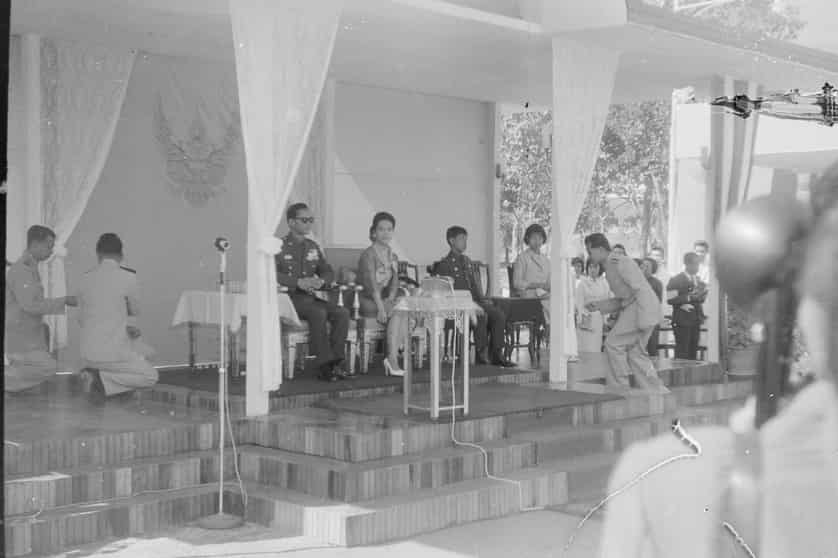My wife and I arrived in Thailand in February 1964, the first farang teachers to be appointed to the brand new Chiang Mai University. Classes did not begin until May, so we spent the first three months designing the syllabus and writing teaching materials. When we reached Chiang Mai in April, only three buildings were finished: an administrative office, a dormitory and a classroom block. We were joined by two colleagues, Ajarns Woralak and Wilai, and later two other British teachers for the English Department, Peter Lugg and Brenda Gillibrand. During the second year Ajarn Kanda took over as the head of English. The Dean of Humanities was M.L. Tooi Xumsai, and the overall director was Professor Buares, who was head of chemistry as far as I remember. Three science teachers from Britain joined the staff, Philip Bradbeer, Alan Forsyth and Alec Gaines.
The Royal Opening took place much later in the year and was a thrilling occasion. The King and Queen came with other members of the Royal Family and were greeted enthusiastically; one got a real sense on that day that we were all trying to turn Chiang Mai University into “the best university in Thailand”.

As well as teaching students who would study for a degree in English, we had to give four hours a week of English to all the students of the science faculty. Here we developed a new approach, asking the students to write instructions for building models, or have them carry out testing of local products such as matches or soap and write up the results in the form of consumer advice, rather than just asking them to do grammar exercises or textual study. This work was written up in a British journal and became influential in a new movement called ESP (English for Special Purposes). It certainly helped me when later I applied to join the permanent service of the British Council.
We took Thai lessons from Roy Hudson and his wife Aporn. I remember sitting in his garden while he explained Thai grammar and she gave us examples to repeat or questions to answer. We also worked with Dr Aree who was in charge of a mental hospital and owned a local radio station. We recorded sets of broadcast English lessons, and he even had a booklet for the series printed by his patients on the press in his hospital. There was no TV station in Chiang Mai, but there was one in Lampang, and I flew there four times to broadcast live a set of programmes giving advice to English teachers (there was no direct road). I suspect very few people ever saw those programmes.

In those days there were only four or five ordinary saloon cars in the whole of Chiang Mai, though there were plenty of tuk-tuks and jeeps or land rovers. There were almost no telephones, and no point in asking for one since there were so few people to phone. The road to Bangkok was not fully paved; there was about 200 miles of laterite which quickly developed ridges and needed good driving to match the rhythm of the car’s springs to the interval between the ridges. The air service was by old Dakota DC3 aircraft, but during our time this was replaced by new Avro turbo-prop planes.
Our appointment was only for two years, so we were unable to see our first students graduate. However, I returned to Bangkok ten years later as an English Language Officer of the British Council, running training courses for teachers, and we then met one or two of our students who had qualified as teachers. I left the British Council in 1986 and joined the staff of Bristol University, and then in 1992 set up a specialised MA course at Stirling University in the use of computers to teach language. At both these places it was a special pleasure to have some students from Thailand with whom to practise our remaining words of Thai, to share memories of places and to enjoy Thai food.

